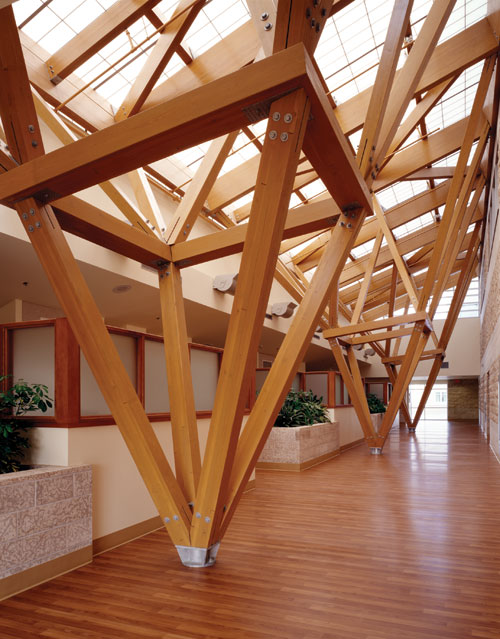Rethinking Wood as a Material of Choice
As trees grow, they absorb carbon dioxide from the atmosphere. They release the oxygen and incorporate the carbon into their wood, roots, leaves or needles, and surrounding soil. One of three things then happens:
- As trees mature and then die, they start to decay and slowly release the stored carbon back into the atmosphere.
- The forest succumbs to wildfire, insects or disease and releases the stored carbon quickly.
- The trees are harvested and manufactured into forest products, which continue to store much of the carbon. In the case of wood buildings, the carbon is kept out of the atmosphere for the lifetime of the structure—or longer if the wood is reclaimed and manufactured into other products. Wood stores more carbon than is emitted during its harvest, production, transport and installation.
 |
According to the U.S. EPA Greenhouse Gas Equivalencies Calculator, estimated carbon benefits for the five-story Avalon Anaheim Stadium equate to a year’s worth of emissions from 2,370 cars or the energy to operate an average home for 1,050 years. Photo by Arden Photography, courtesy VanDorpe Chou Associates |
| CARBON CALCULATOR |
A new calculator estimates the carbon benefits of wood buildings. Users input the volume of wood products, and the calculator estimates the amount of carbon stored in the wood and the greenhouse gas emissions avoided by using wood. If volume information isn’t known, users may select from typical building types. Source: www.woodworks.org |
In all of these cases, the cycle begins again as the forest regenerates and trees once again begin absorbing and storing carbon.
Putting these benefits into perspective, a new carbon calculator5 (see box on the right) found that the Avalon Anaheim Stadium, a five-story building constructed of wood (Withee Malcolm Architects, engineering by VanDorpe Chou Associates Inc.) in Anaheim, California, stored 3,970 metric tons of carbon dioxide equivalent (CO2e) in its lumber and sheathing, while the emissions avoided by not using steel or concrete increased the carbon benefit by another 8,440 metric tons of CO2e. According to the U.S. Environmental Protection Agency's Greenhouse Gas Equivalencies Calculator, this equates to the annual emissions from 2,370 cars or the energy to operate an average home for 1,050 years.
Energy EfficiencyIn terms of operating energy, wood has the advantage of low thermal conductivity compared to steel and concrete. As a result, wood is easy to insulate to high standards while steel and concrete must overcome problems from thermal bridging and the possible consequence of moisture condensation on cold surfaces. However, because there are many factors that have a greater influence on a building's energy efficiency (such as insulation and air tightness), the more relevant point for many designers is that wood building systems lend themselves to structures that are highly energy efficient—with less impact on the environment in terms of embodied energy, air and water pollution, and carbon footprint.
Any wood structural system can be designed to achieve a tight building envelope. However, with new systems such as CLT, precise manufacturing results in tight tolerances and exceptional air tightness. The added aspect of dimensional stability also ensures that the building remains airtight over time. Wood is also proving to be a good choice for designers who want to meet the Passive House (Passivhaus) standard or create a net-zero energy or net-zero carbon building.
 |
Thunder Bay Regional Health Sciences Center in Ontario, designed by Salter Farrow Pilon Architects Inc., was the first hospital in Canada to gain approval for the use of wood as a primary structural element. Photo by www.naturallywood.com |
Recycle/Reuse
One of the most important sustainability factors for a building material is often underestimated or overlooked completely: what will happen to the material at the end of the building's working life? A “Survey on Actual Service Lives of North American Buildings” showed that buildings in the U.S. often have a service life of less than 50 years, regardless of material, because of changing needs or increasing land values as opposed to performance issues. When one considers the embodied energy in these structures and issues related to disposal, the adaptability of wood structures and building systems, either through renovation or deconstruction and reuse, is a significant advantage. (See “Adaptive Reuse” case study on the Barn at Fallingwater at the end of this article.)
Bringing Nature to the Interior Environment
As buildings become increasingly dependent on and designed for technology, the human need to connect with nature doesn't change, but it can get harder to accommodate. Wood has unique characteristics that most people respond to intuitively. This positive connection is now being documented by a growing body of research, and can be a valuable asset in spaces filled with electronic devices and screens, synthetic materials and artificial lighting.
People feel an instinctive connection and attraction to natural materials, and many building designers cite the warm attributes of wood as a reason for its use. Evidence also suggests that exposed wood can contribute to an individual's sense of well-being. In an office or school, wood is thought to improve performance and productivity; in a hospital, it may have a positive impact on patient recovery.
A study6 at the University of British Columbia and FPInnovations found that the presence of visual wood surfaces in a room lowered activation of the sympathetic nervous system (SNS). The SNS is responsible for physiological stress responses in humans such as increased blood pressure and heart rate while inhibiting the parasympathetic system responsible for digestion, recovery and repair functions in the body. The study immersed 119 university students in one of four different office environments, some with wood surfaces and others without. Stress as measured by SNS activation was lower in the wood rooms in all periods of the study. The study concluded that wood is one way to create a healthier built environment.
Study author David Fell says that research on wood and schools is underway, but the results of the office study apply to any interior environment. “The stress-reducing effects we found for wood in office environments are in theory transferable to any building type as these are innate reactions to natural materials.
Another example is the Herrington Recovery Center in Oconomowoc, Wisconsin, a 21,000-square-foot, 20-bed treatment center for executives and business professionals. Cedar and stained wood were used inside and out. Wood ceilings and soffits in the recreation room and entrances to sleeping rooms brought warmth to the space, while exposed glulam beams allowed for soaring ceilings and clerestory windows provided ample natural light. Patient rooms had shorter spans, so the dividing walls between patient rooms were designed as bearing walls. This allowed the use of cost-effective 2x lumber for ceiling joists. “Certainly from a cost standpoint, it made a lot of sense to do the whole thing on a wood frame,” said architect John Curran, ALA, senior vice president for TWP Architecture. “And by using wood in what some might consider an institutional setting, we were able to create a warm and familiar environment to make patients feel more comfortable and more at home.”
Designed by Salter Farrow Pilon Architects, the Thunder Bay Regional Health Sciences Center in Ontario was the first hospital in Canada to gain approval for the use of wood as a primary structural element. Featuring a dramatic three-story wood and glass walkway, the structure incorporates over 1,100 glulam members, some more than 65 feet long. The use of wood extensively throughout the structure provides a bright and optimistic atmosphere for patients, staff, and the community.









